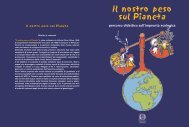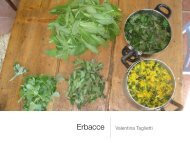Myanmar Protected Areas: Context, Current Status ... - Istituto Oikos
Myanmar Protected Areas: Context, Current Status ... - Istituto Oikos
Myanmar Protected Areas: Context, Current Status ... - Istituto Oikos
Create successful ePaper yourself
Turn your PDF publications into a flip-book with our unique Google optimized e-Paper software.
161 Ficedula parva<br />
Red-throated<br />
Flycatcher<br />
162 Copsychus saularis<br />
Oriental Magpie<br />
Robin<br />
163 Copsychus malabaricus White-rumped Shama<br />
164 Acridotheres tristis Common Myna<br />
165 Gracula religiosa Hill Myna<br />
166 Acridotheres fuscus Jungle Myna<br />
167 Riparia paludicola Plain Martin<br />
168 Riparia riparia Sand Martin<br />
169 Hirundo rustica Barn Swallow<br />
170 Hirundo daurica Red-rumped Swallow<br />
171 Delichon dasypus Asian House Martin<br />
172 Hirundo tahitica Pacific Swallow<br />
173 Pycnonotus atriceps Black-headed Bulbul<br />
174 Pycnonotus finlaysoni<br />
Stripe-throated<br />
Bulbul<br />
175 Pycnonotus goiavier Yellow-vented Bulbul<br />
176 Pycnonotus brunneus Red-eyed Bulbul<br />
177 Pycnonotus plumosus Olive-winged Bulbul<br />
178 Alophoixus pallidus Puff-throated Bulbul<br />
179 Alophoixus ochraceus Ochraceous Bulbul<br />
180 Alophoixus bres Grey-cheeked Bulbul<br />
181 Iole virescens Olive Bulbul<br />
182 Iole propinqua Grey-Eyed Bulbul<br />
183 Prinia hodgsonii Grey-breasted Prinia<br />
184 Zosterops palpebrosus Oriental White-eye<br />
185 Zosterops everetti Everett’s White-eye<br />
186 Gerygone sulphurea<br />
Golden-bellied<br />
Gerygone<br />
187 Acrocephalus aedon Thick-billed Warbler<br />
188 Orthotomus sutorius Common Tailorbird<br />
189 Orthotomus atrogularis<br />
Dark-necked<br />
Tailorbird<br />
190 Orthotomus sericeus<br />
Rufous-tailed<br />
Tailorbird<br />
191 Phylloscopus fuscatus Dusky Warbler<br />
192 Phylloscopus inornatus<br />
Yellow-browed<br />
Warbler<br />
193 Phylloscopus borealis Arctic Warbler<br />
194 Phylloscopus trochiloides Greenish Warbler<br />
195 Phylloscopus magnirostris<br />
Large-billed Leaf<br />
Warbler<br />
196 Phylloscopus tenellipes Pale-legged Warbler<br />
197 Phylloscopus coronatus<br />
Eastern Crowned<br />
Warbler<br />
198 Garrulax pectoralis<br />
Greater Necklaced<br />
Laughingthrush<br />
199 Malacocincla abbotti Abbott's Babbler<br />
200 Pellorneum tickelli Buff-breasted Babbler<br />
201 Pellorneum ruficeps Puff-throated Babbler<br />
202 Macronous gularis Striped Tit Babbler<br />
203 Alcippe poioicephala<br />
Brown-cheeked<br />
Fulvetta<br />
204 Malacocincla malaccensis Short-tailed Babbler<br />
205 Pellorneum capistratum Black-capped Babbler<br />
206 Trichastoma bicolor Ferruginous Babbler<br />
207 Malacopteron magnirostre Moustached Babbler<br />
208 Malacopteron magnum<br />
Rufous-crowned<br />
Babbler<br />
209 Stachyris erythroptera<br />
Chest-nut Winged<br />
Babbler<br />
210 Erpornis zantholeuca<br />
White-bellied<br />
Erpornis<br />
211 Dicaeum agile<br />
Thick-billed<br />
Flowerpecker<br />
212 Dicaeum trigonostigma<br />
Orange-bellied<br />
Flowerpecker<br />
213 Dicaeum concolor Plain Flowerpecker<br />
214 Dicaeum cruentatum<br />
Scarlet-backed<br />
Flowerpecker<br />
215 Anthreptes simplex Plain Sunbird<br />
216 Anthreptes malacensis<br />
Brown-throated<br />
Sunbird<br />
217 Anthreptes rhodolaema Red-throated Sunbird<br />
218 Nectarinia sperata<br />
Purple-throated<br />
Sunbird<br />
219 Nectarinia calcostetha<br />
Copper-throated<br />
Sunbird<br />
220 Nectarinia asiatica Purple Sunbird<br />
221 Nectarinia jugularis Olive-backed Sunbird<br />
222 Aethopyga saturata<br />
Black-throated<br />
Sunbird<br />
223 Aethopyga siparaja Crimson Sunbird<br />
224 Arachnothera longirostra Little Spiderhunter<br />
225 Dendronanthus indicus Forest Wagtail<br />
226 Motacilla citreola Citrine Wagtail<br />
227 Motacilla flava Yellow Wagtail<br />
228 Motacilla cinerea Grey Wagtail<br />
MAMMAL<br />
N° Scientific Name Common Name<br />
1 Elephas maximus Asian Elephant<br />
2 Dugong dugon Dugong<br />
3 Ratufa bicolor Black Giant Squirrel<br />
4 Callosciurus erythraeus Pallas's Squirrel<br />
5 Galeopterus variegatus Sunda Colugo<br />
6 Macaca fascicularis<br />
Long-Tailed Macacque (Crab<br />
Eating Monkey)<br />
7 Macaca nemestrina Southern Pig-Tailed Macaque<br />
8 Trachypithecus obscurus Dusky Langur<br />
9 Tragulus kanchil Lesser Mouse-Deer<br />
10 Sus scrofa Eurasian Wild Pig<br />
11 Tursiops aduncus Indo-Pacific Bottlenose Dolphin<br />
12 Aonyx cinerea Oriental Small Clawed-Otter<br />
13 Paradoxurus hermaphroditus Common Palm Civet<br />
14 Arctogalidia trivirgata<br />
Small-Toothed Palm Civet<br />
(Three Stripe Palm Civet)<br />
15 Pteropus hypomelanus Island Flying Fox<br />
16 Cynopterus sphinx Greater Short-Nosed Fruit Bat<br />
17 Megaderma lyra Greater False Vampire<br />
18 Taphozous longimanus Long-Winged Tomb Bat<br />
19 Manis javanica Sunda Pangolin<br />
In-depth Study of Rakhine Yoma Elephant Range Wildlife Reserve<br />
132 133<br />
4<br />
F. Bianchi<br />
Introduction<br />
The Rakhine Yoma Elephant Range Wildlife Reserve has been selected for in-depth study because of<br />
its vulnerability to the loss of biodiversity due to human pressure in the area. The threats are several:<br />
logging for timber, fuel wood or poles; forest encroachment for cultivation (both permanent and<br />
shifting); trade-driven hunting of endangered species. BANCA has already worked in the area alongside<br />
the Rakhine Coastal Conservation Association (RCCA), among the most important and diffused CBOs<br />
operating in southern Rakhine State, in projects about environmental awareness, community forestry<br />
and biodiversity assessment. RCCA itself has expressed its interest in the result of a research involving<br />
the Rakhine Yoma region; therefore, after a joint consultation, the following objectives for this in-depth<br />
study have been decided:<br />
1) to prepare a land cover map of the Rakhine Yoma Elephant Range Wildlife Reserve and of the<br />
surrounding areas;<br />
2) to conduct a study of the vegetation changes which have occurred in the last decades;<br />
3) to draw up management-relevant recommendations<br />
Land Cover maps usually represent the different vegetation types covering a portion of the Earth’s<br />
surface. Due to the lack of existing reliable maps of the study area, it has been decided to use the<br />
knowledge of both BANCA and RCCA experts, alongside the photointerpretation of remotely sensed<br />
data, such as from Landsat Satellite. BANCA and RCCA experts successfully contributed to the field<br />
survey and actively participated to the map legend formulation. Images acquired from the space are a<br />
powerful tool to discriminate the different vegetation types present on the Earth’s surface, and, given<br />
the possibility to analyse data coming from different years, to study the vegetation change dynamics.<br />
The outputs of this project will provide RCCA with a valuable tool for planning future conservation<br />
activities and addressing current threats, identifying the most vulnerable areas in the Rakhine Yoma.<br />
Although some land cover maps derived from satellite imageries exist for this area, none of these maps<br />
has a fine spatial resolution and an appropriate legend derived from a field survey. The study has also<br />
been extended to the surroundings of the PA to better understand the situation in the more inhabited<br />
regions, and because it is not possible to separate the environment of the Rakhine Yoma from the close<br />
coastal and valley regions situated around it. The Department of Environmental Sciences, Remote<br />
Sensing Lab., University of Milano – Bicocca (Italy), has been directly involved in the process.






